The Wheatsheaf, Wavendon
In the middle of Church End, Wavendon, stands a small single storey white building, with a later extension to the right-hand side. This was once a public house.
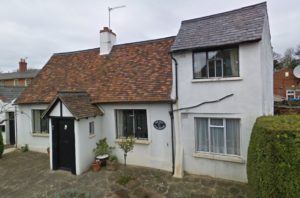
The current owners of “The Old Wheat Sheaf” have kindly shared the early deeds of the building, and they show that in 1755, Edward Tompkins the elder, his wife Judith and his son, Edward the younger, all of Wavendon, sold two cottages or tenements then in the occupation of John Pain and Mary Harcott, and part of an orchard to John Laughton, also of Wavendon. The sale was for £48. In John Laughton’s will of September 1787, in which he is described as a “Joiner”, he left his property in Wavendon for the use of his wife Mary, but only during her lifetime, as it was then to be transferred to William Mapley. When Mapley died, they were left to his son, John Mapley, when the occupier was listed as an Edward Bennett, carpenter. On John Mapley’s death, it passed to his widow Martha (Maria) Mapley. From that point, the surname in the deeds changes to Mabley (…which sounds very similar to a clerk creating the deeds, I imagine!)
Martha/Maria in turn sold the buildings to Thomas Plowman in 1795 for £52 10s. It was still described as “All that messuage, cottage, tenement with yard garden & appurtenances… formerly two cottages in several tenures of John Pain, Mary Harcott, afterwards John Mabley, and piece of ground attached in occupation of Edwards Tompkins and another to north in occupation of King”, with no reference to a public house.
However, in other early deeds for the property, stored at the Centre for Buckinghamshire Studies (CBS) at Aylesbury, the Wheat Sheaf was mentioned when it sold on 28th August 1788, from Richard Higgins of Newport Pagnell, innholder to Gregory Austin for £340, It included “All that messuage or tenement with the appurtances situate standing and being at Wavendon otherwise Wandon aforesaid now used as a public house and called or known by the name or sign of the Wheat Sheaf and in the occupation of Thomas Plowman.” Earlier deeds are listed in a schedule in that deed back to 1677, with the earliest a transfer from Jane Stilos to Thomas Harvey on 31st October 1677, and another in March 1732 of John Harvey to Richard Martin, when it sold for £100, but there are no earlier mentions of it as an inn, just as “messuage & land”. [CBS: D118/7]
CBS also holds some early wills for the Plowman & Austin families, which seem to be closely linked. It appears they were all originally local Cheesemongers. [CBS: D118/17] The earliest reference to the Plowman family in Wavendon parish registers is in 1696.
Proving that the authorities were not always up to date with where public houses had opened, the public house only started to appear in the Bucks Alehouse Register from 1780, when it was being run by Thomas Plowman, but it had no inn sign listed that first year. After that, inn sign names only appear intermittently. The Register runs from 1753, but there are no other inn names it could have been before 1780. Thomas Plowman left it to his wife Ann, but again, no inn was mentioned, and it was just listed as “Two cottages in occupation of William Burrass & Hugh Going.”
In 1817, the Register shows a change of landlord to Thomas Austin Plowman, who remains landlord until the Register ends in 1827, except the year 1826, when the clerk has erroneously entered it as an inn called the Ploughman, run by a Thomas Austin! A slip of the quill…
In the early 19th century, references to the inn start to be found in local newspapers. On the 8th April 1820, the Northampton Mercury ran an advert for John Day & Son, who were conducting an auction “at the sign of the Wheat Sheaf public house in Wavendon”, for an 11½ acre close of rich sward land in Wavendon, currently in occupation of Mr. George Speckley, the butcher.
CBS has the will of Thomas Plowman, a victualler of Wavendon, which was proved in 1827. He leaves all he has to his wife Ann. This included “a messuage divided into two, in occupation of William Burrass and Hugh Going.” However, this will was written in 1804, so those tenants may have long gone by the time Thomas died.
In March 1828, Ann Plowman mortgaged the inn with William Randall of Husborne Crawley for £100. In later deeds, he is listed as being the butcher there. The property is described as “All that messuage, cottage, tenement with yard, garden & appurtenances.. formerly two cottages in several tenures of John Pain, Mary Harcott, afterwards John Mabley, since then Martha Mabley, and then late of William Burrass and Hugh Going, sometime since converted into a public house… by the sign of the Wheat Sheaf, Thomas Austin Plowman in occupation”. There were several further mortgage changes and charges over the years, involving the Barrett family, John Fountain and George Arrrowsmith, all of Newport Pagnell.
The Plowman family held several prominent positions in the village, including a church warden and parish constable but at least one of them fell afoul of the law. A Thomas Plowman was tried at the Bedfordshire Summer Assizes, Bedford, in July 1833 for Larceny. He had stolen: ten pair of breeches, six yards of cloth, three waistcoats, 23 yards of fustian [heavy cotton cloth for menswear], and other goods, all the property of Mr. Thomas Dumpleton, a tailor of Leighton Buzzard. His sentence was seven years transportation, but his gaoler’s report read ‘Character good, strongly recommended to mercy by prosecutor’. A local petition was signed by 55 inhabitants of Leighton Buzzard and Wavendon is stored at the National Archives, pointing out his previous good character; his utmost contrition; and that he had a suffering wife and three infant children. However, it does not appear that these appeals worked, and the paperwork is marked “Removed to the Penitentiary”, and a contemporary newspaper report starts he was transported for seven years. [TNA: HO17/55/31]
The Northampton Mercury has another auction advert on 28th March, 1840. Mr. J. S. Devey held an auction at the Wheat Sheaf Inn, Wavendon, of a dwelling house with bakehouse with two flour rooms attached. It was noted that it had an oven and a pump of good water. The advert advises interested parties to apply to Mr. Samuel King for a viewing, who was probably the owner. They were another prominent family in Wavendon who were Maltsters.
On the 2nd of October, 1841, this colourful story appeared in the Northampton Mercury:
“Caution to Sportsmen. On Thursday week an accident occurred at Wavendon, which might have been attended with very serious consequences. Mr. J. S. Millard, of Woburn Sands, was about leave the Wheat Sheaf Public-house, kept by Mr. Austin Plowman, his double-barrelled gun, as he took it up, caught the end of the table, and one barrel being loaded, went off, the contents passing through the ceiling.
Miss Plowman was sitting in the room above, and not more than a yard from the spot through which the shot penetrated. She fortunately escaped uninjured, but splinters of the wood, and the shots, flew all round her, and so alarmed her, that she fainted. She continued very unwell the next morning. We trust this lady’s narrow escape will operate as a caution to sportsmen not to take their guns into houses, loaded, without taking off the caps.”
The first census to record individual details of householders also occurred in June 1841. The Wheatsheaf is not mentioned by name, but there is a household consisting of:
Thomas Plowman, 59, Publican
James Plowman, 24
Susan Plowman, 20
Maria Plowman, 16
John Plowman, 8
Martha Plowman, 1
Everyone in the household was noted as being born in Buckinghamshire. No further details were recorded on the 1841 census.
From the Bucks Herald of 10th September 1842: “Newport Pagnell Petty Session, August 31st. At the general licence renewal meeting, the licence of Ploughman, at Wavendon was suspended for a fortnight, on account of keeping a disorderly house.” Sadly, the exact nature of the disorder is not recounted!
Maybe the trouble at the inn was more serious than just a few drunkards, as in November, it was put up for sale, under this advert in the Northampton Mercury of 19th November 1842:
“WAVENDON, Bucks. VALUABLE FREEHOLD PUBLIC HOUSE TO BE SOLD BY AUCTION, by MR. GOODWIN, On Tuesday, the 22d November instant, between Four and Five o’clock in the Afternoon, on the Premises.
All that well-known Freehold PUBLIC HOUSE, situate in CHURCH END, in WAVENDON, Bucks, called or known by the name or sign of the WHEATSHEAF INN, together with the yard, garden, stables, barns, brewhouse, buildings, ground hereditaments and appurtenances thereto belonging, now and for many years last past in the occupation of the proprietor, Mr Thomas Austin Plowman.
The Brewing Implements, Barrels, and Stock in Trade to be taken at a valuation by the Purchaser, and immediate possession of the whole Premises may be had.
For further particulars apply to Mr. Plowman on the Premises; at the Offices of Mr. Arrowsmith, Solicitor, or to the Auctioneer, both of Newport Pagnell, Bucks.”
The buyer was William Joseph Nash of Bedford, a brewer with a chain of inns in the district, who paid £400, and thus the inn passed out of local hands and into the world of breweries. Some of the deeds for transactions from this point are stored at the Bedfordshire Archive & Record Service [BARS] Helpfully, a plan of the property was included in the deed. Where did Plowman go after this sale? Perhaps he was still in the trade, as a Thomas Austin Plowman was running the Three Crowns public house in Bridge Street, Northampton, in January 1844, but this may not be the same man.
By the time of the 1847 Kellys Trade Directory, the Wheat Sheaf was being run by William Gooding, a tenant-landlord installed by Nash. This had changed again by the time of the second national census, to a local man, who was to stay for over a decade. In the March 1851 Census, the inn was still not listed by name, but can be identified as the household:
William Facer, 33, Victualler, born Wavendon
Fanny Facer, 36, Lacemaker, born Bringston, Northants
Harriet Facer, 11, Scholar, Wavendon
William Facer, 7, Wavendon
Elizabeth Facer, 3, Wavendon
In the April 1861 Census, it was finally listed under its own sign, as “Church End, Wheat Sheaf Inn”:
William Facer, 43, Innkeeper and butcher, born Wavendon
Fanny Facer, 50, born Brinston, Northants
William Facer, 17, Engine labourer, Wavendon
Facer appears in the Duttons Trade Directory of 1863, and Kellys in 1864, but at the end of the next year, the Bicester Herald of 17th November, 1865, reported:
“Licences – The following publicans licenses were transferred:- The Wheat Sheaf, Wavendon, from Wm. Facer to John Thomas Bird…”
There are no further reports of John Bird’s time at the inn, but a couple of years later, the building was being used as collateral in a deed, under a different landlord.
The brewery that William Nash ran at Bedford could be traced back to at least 1697. It was bought from the Bell family by Thomas Meacher in 1783, but the real buyer was Peregine Nash. Several generation of the Nash family were involved in running it. The estate of pubs it serviced gradually grew, and they rebuilt the brewery in 1819. Bedford Archives & Records Service (BARS) holds a mortgage taken out in July 1867 by William Josiah Nash of Bedford, described as a “Common Brewer, Maltster & Wine and Spirit Merchant” To obtain £4,705.13s.8d., he mortgaged a number of inns which included:
“All that messuage or tenement with the yard garden and appurtenances thereto belonging situate in the Church End of Wavendon aforesaid heretofore in two tenements now converted into a public house and known by the sign of “The Wheat Sheaf” lately occupied by Thomas Austin Plowman and now by ___ Burgess. And also all that small piece of ground wheron formerly stood a leanto adjoining to a Barn formerly occupied by Edward Tompkins situate on or towards the south corner of the public house and premises The premises late of Thomas King & Samuel King and now of ___ lying on or towards the north and part of the east parts of all the said several hereditaments on the remaining part of the east by property now or late of James Harris the Common Street being on the south part thereof and the property now or late of Edward Bennett on the west part thereof”. [BARS: GK161/3]
This is the first mention of the Burgess family, who would run the inn for the next 36 years of its existence. John Burgess had a son in March 1871, and the announcement in the local Croydon’s Weekly Standard included his inn sign name. “Births. March 18, at the Wheatsheaf, Wavendon, the wife of Mr. John Burgess, of a son.”
He appears in the 1871 Mercer & Crockers Trade Directory, then the April 1871 Census entry for “Wheat Sheaf Inn” gives us a few more details about him:
John Burgess, 29, Publican, born Milton, Bucks
Harriett Burgess, 30, Publican’s wife, Harlington, Beds
Lavinia Burgess, 5, scholar, Milton, Bucks
Betsey Burgess, 3, scholar, Milton, Bucks
——— Burgess, 1m, Infant, unbaptised
Ann How, 21, nurse, Milton, Bucks
In 1872, a survey of Beerhouses was taken. The Wheatsheaf is shown as having been licenced over 50 years, with landlord John Burgess, and owner William Nash, of Leighton.
This unusual press report appeared in the Bucks Advertiser of 20th June 1874:
“A Remarkable Visitor – On Wednesday week last a singular-looking animal entered the Wheat Sheaf Inn, Wavendon, and proceeded to one of the bed rooms, where, after having caused great consternation to the occupiers, it was finally captured, and on examination and reference to a work on natural history its captors came to the conclusion that it was a racoon, but how it came to be in the neighbourhood is a mystery. It is still in the possession of the landlord of the inn, waiting to be claimed by the owner.”
John Burgess is listed as at the inn for the 1877 Post Office Directory, and was still there for the April 1881 census, with the infant son un-named on the last census now present as John Thomas:
John Burgess, Inn Keeper, 39, born Milton Keynes, Bucks.
Harriet Burgess, wife, 40, born Harlington, Beds.
Lavinia Burgess, daughter, 15, born Milton Keynes, Bucks.
Betsey Burgess, daughter, 13, born Wavendon, Bucks.
John Thomas Burgess, son, 10, born Wavendon, Bucks.
Emma Burgess, daughter, 6, born Wavendon, Bucks.
The next year, brewer William T. Nash used the inn as collateral again for another mortgage in October, to obtain £3,900 at 5% interest. The schedule includes among many others:
“All the messuage buildings yard and garden situate at Church End in the Parish of Wavendon in the county of Buckingham and now occupied as a Public house known as The Wheat Sheaf in the occupation of John Burgess and bounded on the north by a Malting occupied by Charles Claridge on the south a public highway on the east by a messuage in occupation of Elizabeth King and on the west by the Plough Inn. [BARS: GK161/5]
This report of a theft in an August 1889 Northampton Mercury gives George Burgess as landlord, but the forename George is never used elsewhere:
“Edwin Brown, a 17-year old youth who had deserted from the Reformatory at Carlton, was charged with stealing a watch from a drawer in John Bowler’s cottage in Wavendon. Brown had been employed by Mr. Partridge of the Leathern Bottle in hay-making, and had called at the cottage several times for a drink, when the watch was missed. P.C. George Collier was called, and when the boy was arrested, and the watch found on him, he was also found to be wearing a pair of boots worth 10s., which George Burgess, innkeeper, had noticed missing from his house at 4p.m. that same day. Brown admitted the crimes, and gave no defence. He was committed for trial.”
The Croydon Weekly Standard reported on the case when it came to Court. From the 19th October 1889:
“Edward Brown, 17, labourer, pleaded guilty to stealing a pair, value 10s., the property of John Burgess, at Wavendon, on the 20th of July; and also with stealing a silver watch, value £1 10s., the property of John Bowler, at Wavendon, on the 31st of July. Prisoner had been sentenced to seven years’ penal servitude for arson. After serving part of his sentence at Dartmoor his sentence was commuted to five years in a reformatory, from which place he escaped twice. He was sentenced to three months’ imprisonment on each charge.”
The next month, the Burgess family allowed their land to be used for the annual Wavendon Feast. The Northampton Mercury, 7th September 1889:
“Wavendon – The Feast has been kept up very respectably all the week, the villagers, as of old, having their houses full of visitors. By a judicious arrangement, the swings, steam roundabouts, stalls, &c., were collected in Mr. Burgess’s close, known as Ironmongers, in the very centre of the village, thus keeping the traffic free. Poor old Chance, the fiddler, of ancient days, has passed away, but is not forgotten – his place is filled now by the Wavendon Brass Band.”
Alas, poor Chance, it would appear he is now forgotten! I believe Ironmongers Close is the area of The Maltings, to the north east of the Wheatsheaf.
By 1884, all the male Nash brewing family of Bedford had died out, leaving Susan Nash, William Joseph Nash’s widow, to carry on the brewery for the benefit of herself and her five daughters. She continued running the brewery alone until August 1890, when she went into partnership with William Pritzler Newland, to form “Newland & Nash.”
From the 5th September 1890 Northampton Mercury:
“Wavendon – Cricket. Monday was Feast Day, when a match was played in Ironmonger Close, by permission of Mr. J. Burgess, of the Wheat Sheaf Inn, between eleven from Woburn Sands and eleven of the village. Woburn Sands made 26 and 43, total 69, Wavendon 36 and 35, total 71. A particularly well-served luncheon was provided by Mr. Burgess, of which between 20 and 30 partook. The feast went off successfully, without the least unpleasantness.”
It’s a very small inn to have 20-30 people sat inside, I hope they dined outside!
In April 1891, the next Census took place. “Church End (The Wheat Sheaf Inn)”:
John Burgess, 49, Publican and Farmer, born Milton Keynes
Harriet Burgess, 50, Letter carrier pub, Harlington, Beds
Emma Burgess, 16, Wavendon
In January 1892, Susan Nash mortgaged her properties again, for £6,000 at 5% interest from the Olney brewers, Hipwells. Included, along with most of the same properties as the mortgage in 1882, plus some others, was the Wheatsheaf. [BARS: GK161/8]
Burgess found himself in trouble in August 1894. The Bucks Advertiser & Free Press reported: “Swine Fever Orders. John Thomas Burgess, of Wavendon, was summoned for allowing swine to be removed contrary to the provisions of the Swine Fever Act. Supt. Lait deposed that defendant obtained a licence for removing some pigs which he had bought, and which he had taken home, but had allowed them to be again removed from his premises within 28 days, contrary to the Act. Defendant said that he had acted in ignorance of the law. He admitted allowing the things to be moved, but did not think he had acted contrary to the regulations. Fined 15/- and 9/6 costs.”
The business partnership of Newland and Nash converted to a Limited Company in August 1897. The Indenture of legal transfer includes 59 freehold inns, of which no.55 was listed as “Wavendon, Buckinghamshire, All that messuage known as The Wheatsheaf, with the buildings, yard, garden land and premises and appurtenances belonging thereto situate at Church End. John Burgess”. There were also another 15 leasehold premises included too. [BARS: GK3/1a]
Burgess was still there in 1899 in the next Kellys Directory. William Newland died in August 1900, but the company name Newland & Nash continued to be used.
The Beds Times July 20th 1900 reported on a case brought by a former servant against John Burgess: “DISMISSED. John Thomas Burgess, Wavendon, was summoned by Elizabeth Ann Whatley, Fenny Stratford, to show cause, etc. – Mr Bull appeared for the complainant and Mr. Lathom for the defendant. – The defence was somewhat amusing, it being stated that the complainant when in service had gone out for walks in her master’s clothes. A large number of witnesses were called on both sides. After Mr. Lathom’s opening statement, the Bench stopped the case and dismissed it.”
In the 1901 Census, it is listed as “Wheatsheaf Inn”:
John Burgess, 59, Publican and Carter, born Milton Keynes
Harriet Burgess, 60, Letter carrier pub, Harlington
Betsy Burgess, 33, Cook & Housekeeper (Domestic), born Wavendon
John Thomas Burgess, 30, Carter Carrier, born Wavendon
Emma Burgess, 26, born Wavendon
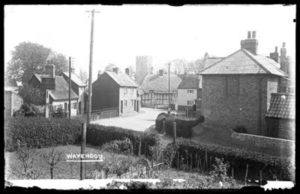
Burgess appears once more in the 1903 Kellys Directory, but he finally passed away on Boxing Day that year, aged 60. As was often the case, his widow took over the inn. Northampton Mercury 8th January, 1904: “Divisional Petty Sessions – The licence of the Wheat Sheaf, Wavendon, was transferred from the late John Burgess to his widow.”
Arrangements were made locally to settle all the business affairs of the late John Burgess. The 20th February 1904, Croydon’s Weekly Standard: “Mr. John Burgess, deceased. All persons having any claims or demands against the Estate of the late Mr. John Burgess, of the Wheatsheaf Inn, Wavendon, Bucks, are requested to send particulars to us, the undersigned. All persons indebted to the Estate are requested to pay the amount of their debts to us by the 1st of March next, after which date proceedings will be taken without further notice. Signed William Lightfoot, John T. Burgess, Executors. Wavendon, Feb 3, 1904.” Lightfoot was the landlord of the Pine Tree Inn, nearby at Walton.
The name J. Burgess is still listed in the 1907 Kellys Directory, but this was an error, as a changeover from the Burgess family to a new landlord was made in October 1905, and recorded in the Buckinghamshire Advertiser: “Transfer:- Mr. Newton, solicitor, Bedford, applied for a transfer of the license of the Wheatsheaf, Wavendon, from Mr. Sturges [sic] to Mr. Tyser. [sic] The Bench granted the transfer but wished it to be made known that they desired in cases of application for the transfer of licenses that notice be given to their Clerk prior to the sitting of the Court at which the application would be made.”
(The reporter’s shorthand must have been too hard for the printer to read!)
The correct name for the new landlord appeared in the Census in 1911, with the address given as “Wheatsheaf, Wavendon”:
Arthur William Tysoe, 26, Carter, born Bromham, Beds.
Florence Tysoe, 26, Assisting in business, born Chelmsford, Essex
Joseph Savage, 25, Boarder, Dealer, Cranfield, Beds.
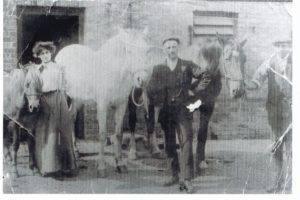
The Wheatsheaf only lasted a few more years, and Tysoe was there until the end. The 16th January 1914, Luton Times and Advertiser reported: “Ten public-houses are to be voluntarily closed by the Bucks. Brewers Association without compensation in consideration of the Licensing Justices making no levy for the compensation fund during 1914. The houses to be closed include the ‘Old Wrestlers,’ Linslade Division, and the ‘Wheatsheaf,’ Wavendon.”
There is no report of the official closing other than that. It is likely it closed down around about the start of the First World War. The brewery took a £20 deposit from a Mrs Mary Annie Tysoe in November, with £65 more due to be paid in January 1915 for “messuage known as “The Wheat Sheaf” (to which a licence for the sale of intoxicating liquor by retail was lately attached but which licence has now ceased to exist)”, and thus the Wheatsheaf became a private dwelling again after approximately 135 years. The deed very specifically mentions that it was Mrs Tysoe buying the building, independently of her husband.
There are a couple of press reports about the Tysoe family after that. The Buckingham Advertiser reported he had pleaded not guilty to being the owner of a dangerous dog in September 1914, but was ordered to keep it under proper control and to pay costs of 14s. 6d. This obviously didn’t work, as Beds Times reported in March 1915 that Arthur Tysoe, carter, Wavendon, did not appear to a charge of failing to comply with an order made by the bench to keep his dog under control. – Case adjourned for a fortnight, defendant to pay costs for that day.
By the middle of the war, with demands for more troops being made, Tysoe appears to have signed up, as this advert appears in the Beds Times 28th July 1916: “For Sale: Two working HORSES, one a Grey Cob. Selling through owner enlisting; also Lady’s cycle – Tysoe, Wavendon, Woburn Sands”.
He survived the war, and came back to Wavendon. In 1939 the National Registration Act required all citizens to have an ID card, and another census-type listing was compiled. The Register shows “White Cottage”, but this seems to be more descriptive than an indication of a building name, as there are several instances of it in Wavendon alone.
Arthur W Tysoe, born 11th April 1881, a stockman on farm
Walter Tysoe 16th November 1876, a farm assistant
Tysoe died in Wavendon in September 1949. His relative who owned the building had died in November 1935, so the building had then transferred to three other members of the extended Tysoe family. It was gifted by them “in consideration of natural love and affection” in July 1950 to one Lawrence Charles Curtis, with Walter Tysoe still in occupation. The sellers were Curtis’ uncle, mother and aunt, but exactly a year later, Curtis sold it again. The deed says with Walter in occupation, but this is wrong, as he had died by May 1951. The house was sold by Curtis at an auction at the Plough next door. From 11th May 1951 Beds Times:
“Walter Tysoe, deceased. WITH VACANT POSSESSION. WAVENDON (1 mile north of Woburn Sands, 4 miles Bletchley, 4 miles Bedford). The Freehold Old Fashioned Detached COTTAGE, STABLING, AND YARD standing in the centre of the village, formerly a Public-House known as “THE WHEATSHEAF”, but in private occupation for the last 30 years, containing Bar Parlour, Tap Room, Beer Cellar, “Snug”, Store-room, Scullery and 4 Bedrooms, together with brick and slated 2-stall Stable and Loft, Barn, Cart Shed, Stables, and Yard. Main Water and Electricity available. Will be offered by Auction (unless previously sold by private treaty) at THE “PLOUGH” INN, WAVENDON, on FRIDAY, 25th MAY 1951, at 6 o’clock (subject to conditions to be then produced by FOLL & PARKER.”
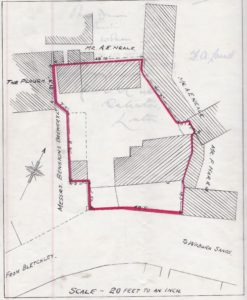
The buyer was a Mr Wadsworth of Blackpot Farm, Leighton Buzzard, who paid £875 for it. He sold it for £1100 two months later, to a Mr Laird of Markyate. It was he who erected the garage at the side of the property in 1952. He was only there a couple of years, before it was sold to the Macleod family of Leighton Buzzard.
The Royal Armouries Archive holds the papers of Sir James Gow Mann, amongst which is a letter dated 20th June 1955, from a Lt. Col. R. T, W. Macleod, of The Old Wheatsheaf, Wavendon, Bletchley, making an appointment to show him a ‘Scottish broadsword’ for identification.
Merial Mcleod died in 1963, and the house was auctioned again, a very detailed catalogue being produced for the sale by Allott & Barnard at the Swan Hotel Bedford. It was bought by the Eyres family, from which it has only recently been sold.
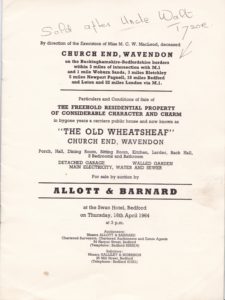
In 1970, Bucks County Council required part of the front garden for road widening, and so exchanged a plot of land to the east of the building for part of the frontage.
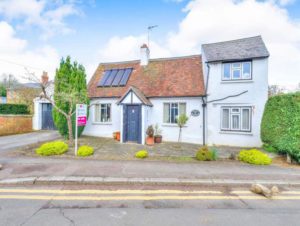
The Old Wheatsheaf was up for sale in April 2018, described as “A rarely available 18th century former public house situated in the small parish of Wavendon close to Woburn Sands and Milton Keynes. The property has been occupied by the same family for over 50 years.” It was bought by new owners who wish to retain as many of the historic features as possible.
As to the brewery, Newland & Nash had eventually been taken over by Wells & Winch of Biggleswade in 1922. They in turn were acquired by Greene King & Sons Ltd in 1961, along with 287 public houses.
From 2018 Sale Particulars.
????-1755 Edward & Judith Tompkins, and son Edward Tompkins
1755-1787 John Laughton
1787 -???? Mary Laughton
????-1795 Mapley family (Became a public house by 1780)
1795-1817 Thomas Plowman (Had been landlord since 1780)
1817-1842 Thomas Austin Plowman (Sold up to William Nash)
1847 William Gooding
1851-1865 William Facer
1865 John Thomas Bird
1867-1904 John Burgess (Owners became Newland & Nash Ltd)
1904 Mrs. Burgess
1911-1951 Arthur William Tysoe (Until closed in 1914. Tysoe family bought it)
1951-1951 Wadsworth
1951-1953? Laird
1953?-1963 Mcleod
1963-2018 Eyres
Page last updated Feb. 2019.
